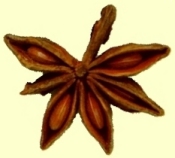Categories
Calendars
Guides
Reviews
Archive
Gallery
Articles
Ask Our Gardening Expert
The Herb Star Anise
Star
Anise
Star Anise has hit the news recently because it is used in
production of the drug Tamiflu. At the current time, Tamiflu is the only drug the world has which may reduce
the severity of Bird Flu (also known as Avian Flu). Note that
the drug will not prevent Bird Flu, it will only only reduce the
severity of it.
Apart from its properties in reducing the
effects of Bird Flu (Avian Flu), Star Anise has been used in
oriental cooking for thousands of years. One of its main uses in
oriental cooking is as a flavouring for duck dishes. It is also
occasionally used as seasoning in Christmas cooking. Star Anise
is also widely used in arts and crafts materials.
The herb Star Anise is the little egg-shaped
fruits in the plants. The fruits are dried when semi-ripe. The
taste of the herb is liquorice in flavour and it is very pungent. Currently Star Anise is a native of Southern China
and Vietnam. However only the Chinese variety is useful in the
treatment of Bird Flu. It is best suited to tropical conditions. The Latin name for Star Anise is Illicium verum,
an evergreen tree of the Magnoliaceae family.
Note that Star Anise is similar to Anise but not the same. Star Anise has a much stronger liquorice flavour compared to anise. Kings can be quoted as follows on the medicinal uses of Star Anise. "Both the seeds and oil of star-anise possess the stimulant, diuretic, carminative, and slightly anodyne properties of anise. Locally applied and internally administered, they have been used for abdominal pains, particularly when associated with flatus, and in bronchitis, and locally alone in earache and rheumatic complaints. Oil of star-anise is largely employed to impart a flavour to spirits, especially in France, Germany and Italy."
Star Anise was introduced into Europe in the 17th Century where it was used in baked goods and in the making of fruit jams. More famously it was used as one of the main flavourings of the liqueurs Pernod an Anisette.
The Star Anise tree grows to about 2.5 m tall (8 foot) and grows best in an acid soil. The soil should also be water-retentive because Star Anise does not tolerate shortage of water well. Unusually, the tree takes about six years before it begins to bear fruit but it does survive into very old age for such a small tree, in some cases over 100 years.
END OF STAR ANISE ARTICLE